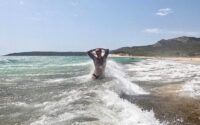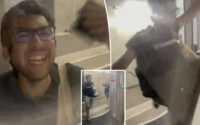South Pole resident reveals extreme challenges of Antarctica life
She’s having a snowball on the South Pole.
A travel blogger from San Francisco is sharing what life is actually like in the frozen tundra of Antarctica — along with the adjustments she’s had to make to call it home for nearly a year.
“It’s too cold and too far from the ocean for penguins, unfortunately,” Michelle Endo, 32, told Newsweek on Monday. “At 5 feet, 3 inches, I’m one of the smallest living organisms here!”
Inspired by the Antarctica episode of Anthony Bourdain’s “Parts Unknown,” Endo enrolled in the National Science Foundation’s US Antarctic Program as a hospitality manager within the Amundsen-Scott South Pole Station.
The location usually registers temperatures of minus 76 to 122 degrees Fahrenheit, Endo says.

“Despite the harsh conditions, I love going for walks, especially when the auroras are out,” she said, adding that life at the dormitory-style station includes perks like freshly baked desserts.
“Food and housing are provided as part of the program since there are no apartments, grocery stores, or restaurants here, just the station.”
Endo says the once-in-a-lifetime opportunity does require a major “time commitment.”
“At the South Pole, summer contracts are three months, and winter contracts are nine months to a year long. During this time, you live at the station full-time and only leave at the end of your contract,” she explained.
Base residents also endure tough circumstances beyond frigid temperatures.
“Everyone knows about the extreme cold at the South Pole, but one of the major adjustments that many people don’t think of is the high elevation,” she added.
“We sit at 9,301 feet [above sea level], and the pressure altitude can be significantly higher. The first week here can be challenging; we’re even told not to go to the gym in our first seven days while we acclimate. Even after being here a year, I still struggle to breathe at times climbing a flight of stairs.”

Total darkness, common for half the year, is another startling condition.
“Not seeing the sun for six months can be a real challenge. We take vitamin D, and use artificial sun lamps to help counter the effects. Similarly, for six months of the year, there’s only sunlight!” Endo exclaimed.
Though she connects with colleagues on the base, Endo warns that ice-olation is but one more challenge people should be mindful of before opting for a year in the Antarctic.
“I’ve seen the same 42 faces for the last eight months. I miss hanging out with people I don’t work with since we all live and work together here,” she said. “I also haven’t seen any animals or trees in a year.”


